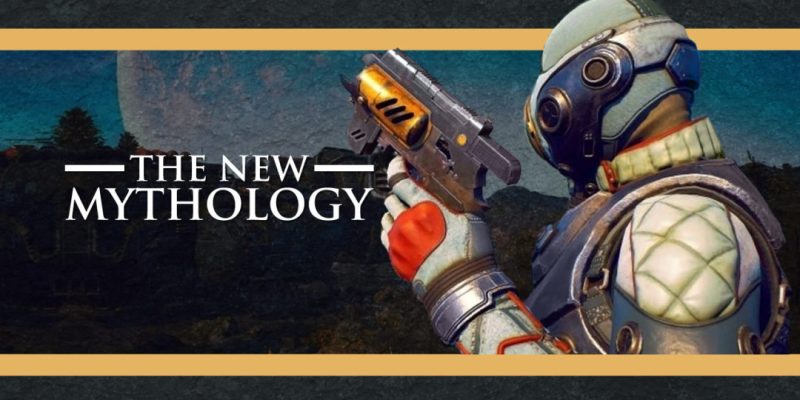Space Western: A pernicious form of used furniture where every Martian or Jovian town looks and sounds like Dodge City. – author Lewis Shiner
The Outer Worlds is a totally unsubtle lampoon of unrestrained capitalism, a triumph of nonlinear storytelling with some great offbeat characters. It is also a great example of the once-maligned Space Western genre.
The Western isn’t a solely American genre — there’s an entire beloved Italian subgenre just for starters — but apart from superhero stories, it’s the genre that most clearly expresses American desires. A lot of us dream of vast open spaces, unspoiled countryside, and picturesque desolation, a frontier where an outlaw can flout society and sleep under the stars or a lawman can be justified in doling out violent retribution.
The Western was the dominant fictional genre for generations in the same way the superhero genre has become inescapable. The Wild West was the go-to setting for writers of American dime novels, radio serials, TV shows, and sweeping film epics. As the Hollywood studio system began to collapse, Westerns delivered some of the era’s best and most complicated material like The Searchers, The Wild Bunch, and the entire first half of Clint Eastwood’s career.

The genre had largely petered out by the ’80s, and despite the odd hit like Django Unchained, it’s never really recovered. There are a lot of reasons this might be the case. The genre is deeply ingrained with the ideas of Manifest Destiny, white civilization winning out over “savagery,” and the idea of frontier justice where a few bold folks must deliver retribution because the system is broken. The generation enamored with that general worldview is graying, and there are fewer people who were raised on Gunsmoke or Have Gun — Will Travel in positions of influence in the entertainment industry.
As pulp science fiction rose in prominence, it was only natural in retrospect that workaday writers would mash it up with Westerns. Star Trek made the parallel explicit in the intro to each episode: “Space, the final frontier.” The American West was long gone, and the nation was now dreaming about rocket ships and distant planets. The promise of undiscovered worlds unspoiled by civilization stood in for the American wilderness, and bug-eyed aliens became the new Other.
But people quickly got sick of the idea of conflating the Western with science fiction. In 1950, the back cover of the first issue of the science fiction magazine Galaxy promised that it would never include any Space Western stories. “If such hack work could arouse thought then we should think what a pity it is that our idiotic species is shortly proposing to spread its dreary melodramatic doings from here to Sirius,” novelist and playwright J. B. Priestley wrote of the genre in a 1953 issue of the New Statesman.
The genre didn’t vanish entirely, but it was discredited enough that it didn’t begin to recover until Star Wars, which was filled with exotic backwaters populated by rugged outlaws. It’s pretty easy to trace the genre after that, at least for those of us old enough to remember Saturday mornings spent watching BraveStarr, nights of recovering from a retail graveyard shift with episodes of Trigun, or a sad lifetime of mourning Firefly.

With its six-gun-styled weapons, lawless stretches of wilderness, and jangly musical cues accompanying scenes of interplanetary travel, Obsidian Entertainment’s The Outer Worlds pulls off the incredible trick of both seeming like it belongs in the Space Western lineup while also serving as a perfect spiritual successor to the Fallout games. Obsidian’s founders were devs at Black Isle Studios, and as earthbound and post-apocalyptic as that company’s Fallout 2 was, it still contained copious references to both Westerns and classic science fiction including The Day the Earth Stood Still, Forbidden Planet, and The Good, the Bad and the Ugly.
That flavoring was found in Bethesda’s Fallout 3, but it defined the look and feel of Obsidian’s Fallout: New Vegas. The main story casts the player as a lowly courier who simply wants to find out why some malcontents shot them in the head and left them for dead. Weapons, garb, and character options all gleefully guide the player into a quickdraw cowboy build they can use to wander the Nevada wilderness.
The Outer Worlds is another example of Obsidian taking a different company’s intellectual property or game mechanics and just doing a better job with them. It’s pretty fitting that a story about capitalism running totally amok would be framed as a Space Western, a fusion of two genres whose best stories about far-off frontiers are grounded in contemporary anxieties. The stern old professor and the sad outlaw both fear the march of progress, whether it’s a railroad run by violent crooks or a bomb that’s going to wake up Godzilla.
The Outer Worlds creates dazzlingly pretty landscapes filled with imperfect people trying to survive, and even a sourpuss like Vicar Max will admit they mean well. All of that is in danger of being erased by corporate greed and the complacency of a population that’s come to believe you should owe your boss when you call in sick or leave your post because the bean counters have reprogrammed the security robots to kill you as part of a tax write-off. It’s the kind of world that benefits from a savior who makes atmospheric reentry with a big iron on his hip.
